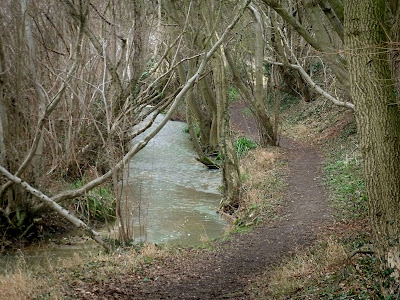"Reuben's Corner" is one of those tatty little paperbacks that has hung around for a long time, has been picked up on countless occasions and is now looking rather the worse for wear. It's a simple story of Spike Mays' childhood in the early part of the twentieth century. The reviewer from The Sunday Times, no less, thought it a better book than 'Cider with Rosie', so it's a mystery why it has so long been out of print; though second-hand copies are available at very reasonable prices. And Mr Mays just happened to grow up in Ashdon, in Steventon End, Ashdon to be precise. I've long wanted to pay a visit to see if anything remained of Reuben's Corner.
I don't usually take much notice of Anonymous but I was glad to receive this information:
If you weren't aware, Mays's book has recently been republished (by Abacus) with a 'Misery Lit'-style cover and cringeworthy renaming: "The Only Way Was Essex". Available now from all good booksellers, tax-dodging online retailers and doubtless an aisle in Tesco, alongside all those other identically-marketed "We was poor but happy" memoirs.
(non-British readers may need to know that The Only Way IS Essex is the name of a TV programme in the UK - no, you don't want to see it!)
Walton's Park was where Spike Mays worked as a houseboy on leaving school. By poking a camera over the top of the wall I was able to get a view of the house.
Walton's
This moved Penelope to share this snippet:
I walked on past Place Farm, where he worked later. In the prologue he remembers the farmhands walking to work in the early morning - Toe-Rag Smith, Walt Stalley, Poddy Coote, Wuddy Smith - their cheerful voices and the plod of their hobnailed boots on the gravel road. No sound of boots now; everyone had driven off in their cars to work in town. Instead a woman jogged by in pink running shoes!
More recently, 14 July 2015, Jan Pearson added a comment:
I have just discovered this - albeit a bit late in the day - and was delighted to see Toe-Rag Smith get a mention. He was my Great-Grandfather!
Place Farm
Kathy Bowry commented on 16 December 2013
My mother Marion Weir 'found' Spike for Eyre Methuen when general book editor there and editing Colonel A D Wintle's diaries. (Spike was his batman in the Royal Dragoons). All Spike's books are still a brilliant read and it is marvellous that he is still in print.
Kathy Bowry was back again on 2 April 2015 to give a further recommendation:
Spike also co-wrote a book with his best friend Chris Ketteridge 'Five miles from Bunkum: a village and its crafts' also published by Eyre Methuen, published 1 January 1972.
Chris Cornwell added on 19 January 2014
I also bought a copy of "The Only Way Was Essex" only to find it was a reprint of "Reuben's Way", itself (presumably) a reprint of "Reuben's Corner". I also googled Mays to find your excellent account of your "pilgrimage". I will be following in your footsteps . . . Richard Church in the Foreword mentions S L Bensusan who wrote about estuary life in Essex..... Finally may I recommend Out of Essex by James Canton, particularly the chapters on Shakespeare and J A Baker.
Thanks again to everyone who has visited and commented.
Take care.


















































